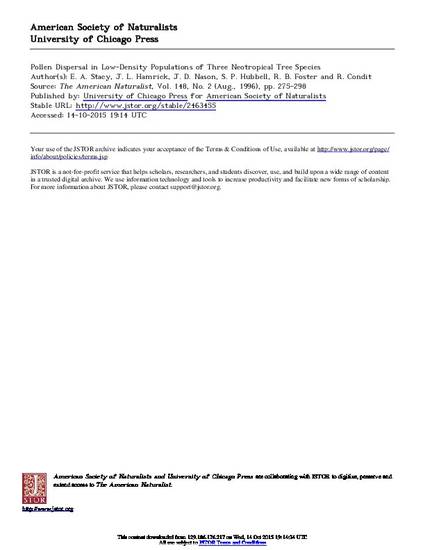
Article
Pollen Dispersal in Low-Density Populations of Three Neotropical Tree Species
The American Naturalist
(1996)
Abstract
Studies of mating patterns of tropical trees, typically involving common species, have revealed that most species are outcrossed and that, in some cases, a significant fraction of outcross pollen moves long distances. We evaluated mating systems and effective pollen dispersal for three hermaphroditic, insect-pollinated Neotropical tree species, Calophyllum longifolium, Spondias mombin, and Turpinia occidentalis, all of which occurred at low adult densities at the study site. Mating patterns were estimated for each maternal tree within 84-ha populations of C. longifolium and S. mombin in 1992 and 1993 and within a 50-ha population of T. occidentalis in 1993. Each population was 100% outcrossed. Multilocus paternity exclusion analyses indicated that in C. longifolium, a minimum of 62% of effective pollen moved at least 210 m. For S. mombin, estimates of apparent pollen flow greater than 300 m were 5.2% and 2 5% in 1992 and 1993, respectively. For all species, pollen dispersal was strongly affected by the spatial distribution of reproductive trees. Where flowering adults were evenly spaced, a large fraction of effective pollen moved at least a few hundred meters and well beyond the nearest reproductive neighbors. Conversely, where flowering trees were clumped, the majority of matings were among near neighbors. The minimum area required to encompass a natural breeding unit was estimated for each population.
Disciplines
Publication Date
August, 1996
DOI
10.1086/285925
Publisher Statement
Copyright 1996 by The University of Chicago
Citation Information
E. A. Stacy, J. L. Hamrick, J. D. Nason, S. P. Hubbell, et al.. "Pollen Dispersal in Low-Density Populations of Three Neotropical Tree Species" The American Naturalist Vol. 148 Iss. 2 (1996) p. 275 - 298 Available at: http://works.bepress.com/john-nason/2/
